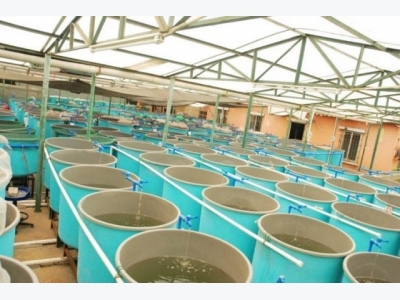Supplemental selenium boosts plant-based aquafeed

Adding selenium to plant-based fishmeal may improve growth, performance of farmed seabass.
A team of international researchers studied the effect of adding selenium (Se) to diets replacing fishmeal with plant proteins and used to produce carnivorous fish. The group reported their results in the journal Aquaculture.
“This study was carried out to investigate the effect of organic selenium (OS) supplementation in barramundi diets containing LM as the major dietary protein source,” said team members in the report. “Growth performance, feed utilization, blood chemistry and histopathology were particularly examined.”
The group found that including selenium in the plant-based diet improved several production measures including final weight (FW), specific growth rate (SGR), weight gain (WG) and reduced Se-induced myopathy.
“These results suggest that high LM diets supplemented with organic selenium can enhance growth, physiological and histological performances of juvenile barramundi,” said the researchers.
Why selenium
Fishmeal (FM) is a primary protein used in the creation of fishfeeds for aquaculture, but prices continue to increase as the aquaculture sector grows, said the researchers. As the product is made from fish, or fish by-products, use of the meal also generates concerns about its sustainability.
These factors establish interest in reducing the amount of fishmeal used in aquaculture and shifting to a non-fishmeal protein source, they said.
A number of studies have examined ingredients, feeds and production systems based on the idea of replacing fishmeal with a plant protein (PP) source, said the researchers.
“Among PP sources, lupin meal (LM, Lupinus angustifolius) has received considerable attention as a potential alternative to FM because of its comparatively balanced nutritional profile, desirable palatability, high digestibility, cheaper price and reliable supply (Gatlin et al., 2007),” they said.
Past studies have demonstrated the ability for a limited amount of LM to be used in fish diets, they said.
“A number of studies show that partial or high replacement of FM with LM (≥ 50%) is conceivable at least in rainbow trout (Oncorhynchus mykiss) ( Borquez et al., 2011, Burel et al., 1998, Farhangi and Carter, 2007 and Glencross et al., 2004),” said the team. “The reasons for a discrepancy among aquaculture nutritionists on the utilization of LM as a protein source for fish might be associated with a number of factors including product quality, treatment and inclusion levels of LM, feed formulation, culture condition, fish size and variations in fish species.”
In carnivorous species, there can be a reduction of performance and health when high amounts of FM are replaced with plant material, they said. This can stem from a lack of amino acids, poor nutrient digestibility, anti-nutritional factors and lower energy content.
Se supplements have shown benefit in other studies, but no work has been done using a plant-protein based diet, said the researchers. Therefore, the experiment was done to examine if the additive could allow for a higher inclusion of LM in a carnivorous fish diet – here the barramundi or Asian seabass.
Experiment details
In the experiment, a 2x3 experiment layout was used to compare the effects of aqua feed that used several levels of lupin meal (LM) as a plant protein and varying amounts of organic selenium (OS), said the researchers.
Six experimental diets were used, they said. The diets included LM diet at 0, 25 and 75% and those diets with either 0 or 2g kg-1 organic selenium.
The feeding trial ran for 60 days and involved 360 juvenile barramundi, they said. Fecal samples were collected for the final week of the experiment, body weights were taken at the start and end of the trial and blood samples were gathered.
Total Se was established in diet and muscle tissue, they said. And, segments of muscle, liver, kidney, spleen and intestine were collected from sample fish.
SGR, WG, feed intake, the feed conversion ratio, survival rate, apparent digestibility coefficient of protein (ADC-P) and thermal growth coefficient were all calculated, said the researchers.
Results
Fish getting the PP diet and Se supplement outperformed fish getting only the plant-based diet, said the researchers. No significant differences in feed intake were noted.
Fish with the Se diets had improved weight gain, specific growth rate and weight gain, they said. Survival rates and thermal growth coefficient were similar for all groups of fish.
The ADC-P was influenced by the level of lupin meal and the inclusion of selenium in the diets, said the researchers.
“Fish fed diets containing OS supplement attained higher ADC-P in comparison with those fed OS-deficient diets,” they said. “In addition, irrespective of OS supplementation level, ADC-P decreased as dietary LM increased.”
Higher levels of LM in the diet decreased the activity of glutathione peroxidase (GPx), for fish getting the non-supplemented diet, they said. Supplemented fish had higher leucocrit amounts.
“There was a linear relationship between muscle Se level and Se concentration of the experimental diets,” said the researchers. “Se-induced myopathy was observed in skeletal muscles of fish fed LM diets without Se supplementation.”
In fish not getting the supplement there also was a “structural alteration” in the liver, they said.
Có thể bạn quan tâm
 Tallow may offer lipid option for salmon feed
Tallow may offer lipid option for salmon feed Salmon may see a new feed ingredient in tallow, which maintains growth and improves fillet quality.
 Do pineapple trimmings have a place in aquafeed?
Do pineapple trimmings have a place in aquafeed? A feed product made using pineapple peelings may boost growth, health and production of farmed prawns.
 Does enzyme use ensure higher gain in tilapia production?
Does enzyme use ensure higher gain in tilapia production? Adding phytase to plant-derived tilapia diets may boost nutritional gain and offer improved growth performance and intestinal health.